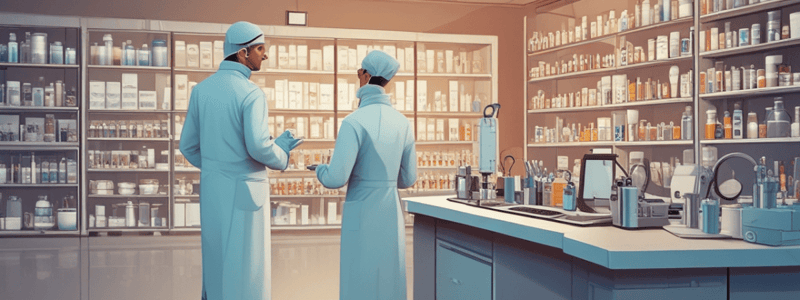Podcast
Questions and Answers
What is the primary focus of Quality Control in a medical laboratory?
What is the primary focus of Quality Control in a medical laboratory?
To detect, reduce, and correct deficiencies in a laboratory’s internal analytical process prior to the release of patient results.
What is the purpose of including quality control samples in analytical runs?
What is the purpose of including quality control samples in analytical runs?
To evaluate the reliability of a method by assaying a stable material that resembles patient samples.
When should quality control material be run?
When should quality control material be run?
At the beginning of each shift, after an instrument is serviced, when reagent lots are changed, after calibration, and when patient results seem inappropriate.
What is the purpose of the Levey-Jennings chart?
What is the purpose of the Levey-Jennings chart?
What comes first, Quality Assurance (QA) or Quality Control (QC)?
What comes first, Quality Assurance (QA) or Quality Control (QC)?
What is the purpose of Proficiency Testing (PT) or External Quality Assessment (EQA)?
What is the purpose of Proficiency Testing (PT) or External Quality Assessment (EQA)?
What is the main purpose of a program like ISO 15189?
What is the main purpose of a program like ISO 15189?
What is the standard deviation used for in laboratory quality control?
What is the standard deviation used for in laboratory quality control?
What is plotted on the X-axis and Y-axis of a Levey-Jennings chart?
What is plotted on the X-axis and Y-axis of a Levey-Jennings chart?
What is the primary goal of a laboratory accredited to ISO 15189?
What is the primary goal of a laboratory accredited to ISO 15189?
What is the role of quality control professionals in laboratories?
What is the role of quality control professionals in laboratories?
What is the significance of ISO 15189 in medical laboratories?
What is the significance of ISO 15189 in medical laboratories?
How many countries had made ISO 15189 part of their mandatory medical laboratory accreditation requirements by 2015?
How many countries had made ISO 15189 part of their mandatory medical laboratory accreditation requirements by 2015?
What is the focus of a laboratory implementing ISO 15189?
What is the focus of a laboratory implementing ISO 15189?
What is the significance of employee involvement in a laboratory implementing ISO 15189?
What is the significance of employee involvement in a laboratory implementing ISO 15189?
What is the significance of accreditation to ISO 15189 in the United States?
What is the significance of accreditation to ISO 15189 in the United States?
Flashcards are hidden until you start studying
Study Notes
Quality Assurance and Quality Control
- Quality Assurance provides assurance that quality requested will be achieved.
- Quality Control is a procedure that focuses on fulfilling the quality requested.
- Medical Laboratory Quality Control is designed to detect, reduce, and correct deficiencies in a laboratory's internal analytical process prior to the release of patient results.
Quality Control Samples
- Quality control samples are special specimens inserted into the testing process and treated as if they were patient samples.
- These samples are exposed to the same operating conditions as patient samples.
- The purpose of including quality control samples in analytical runs is to evaluate the reliability of a method by assaying a stable material that resembles patient samples.
Quality Control and Precision
- Quality control is a measure of precision or how well the measurement system reproduces the same result over time and under varying operating conditions.
- Quality control material is usually run:
- At the beginning of each shift.
- After an instrument is serviced.
- When reagent lots are changed.
- After calibration.
- When patient results seem inappropriate.
Standard Deviation and Levey-Jennings Charts
- Standard deviation is a statistic that quantifies how close numerical values (i.e., QC values) are in relation to each other.
- Standard deviation is commonly used for preparing Levey-Jennings (L-J or LJ) charts.
- The Levey-Jennings chart is used to graph successive (run-to-run or day-to-day) quality control values.
- A chart is created for each test and level of control.
Proficiency Testing (PT) or External Quality Assessment (EQA)
- Proficiency Testing is a program in which multiple specimens are periodically sent to a group of laboratories for analysis.
- The purpose of PT is to evaluate the laboratory performance with regard to the testing quality of patient samples.
ISO 15189:2007
- ISO 15189 is for use by medical laboratories in developing their quality management systems and assessing their own competence.
- ISO 15189 is used by accreditation bodies in confirming or recognizing the competence of medical laboratories.
- ISO 15189 was first published in 2003 and revised in 2007 and again in 2012.
- ISO 15189 encourages full involvement and utilization of the abilities of all employees at all levels to improve the organization.
- In a laboratory accredited to ISO 15189, the goal is continual improvement, and for staff members to know exactly what to do, how to do it, who is in charge of a process, and where to find all information necessary to perform their jobs.
- By 2015, about 60 countries had made ISO 15189 part of their mandatory medical laboratory accreditation requirements.
- In the United States, accreditation to ISO 15189 is voluntary, as no governmental or regulatory agency requires laboratories or health care providers to conform to ISO 15189.
Studying That Suits You
Use AI to generate personalized quizzes and flashcards to suit your learning preferences.




